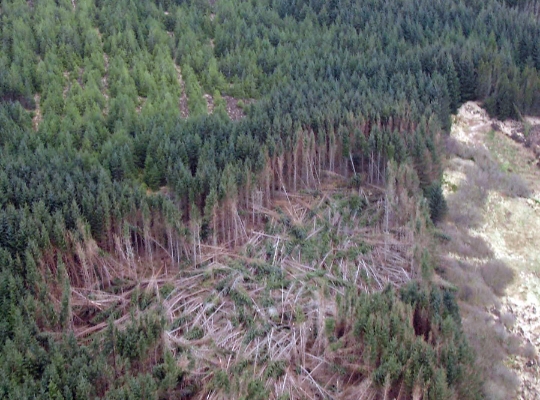The climate in Scotland is changing, and these changes will impact on Scotland’s trees and forests.
The main climate change risks to Scotland’s forests are summarised here, along with resources to support adaptation. We also provide information about Scotland’s climate change policies, forest governance, and grant support.
The climate in Scotland has already changed, with further changes projected. There will be further increases in mean temperatures in all regions of Scotland, and in all seasons, including milder winters with fewer days of ground frost and lying snow. Rainfall patterns will also change, with drier summers and wetter autumns and winters. An increase in the frequency and intensity of extreme events, such as high winds, storms, flooding, heat waves and droughts is also likely.
These changes in climate will have a range of impacts on forestry in Scotland. These impacts should not be seen in isolation; any number or combination of these impacts may be experienced. Impacts include:
The Third UK Climate Change Risk Assessment (CCRA3) 2022 includes a Regional Summary of the Evidence-Report-for Scotland and a UK sector briefing for land use, land-use change and forestry (LULUCF).
Forest Research provide a list of climate change key findings and recommendations, and a list of Resources for Adapting Scotland’s forests to a future climate.
A series of short film clips show how climate change might affect Scotland’s forests and give guidance on how to increase resilience to climate change threats.
Contingency planning can increase adaptive capacity and enable a more rapid and efficient response to climate change risk events.
Adaptation Scotland provides tools and resources to support the public and private sector adapt to climate change.

Winter storms in 2021 led to large areas of windthrow across Scotland.
Scottish Forestry are the Scottish Government agency responsible for forestry policy, support (including grants) and regulations.
Forestry and Land Scotland (FLS) manages the public forest estate in Scotland. The FLS Climate Change Plan describes how they are working to mitigate the effects of the Climate Emergency and are adapting to anticipated climate change and pest and disease threat.
Scotland’s Forestry Strategy 2019-2029 outlines the visions and actions to expand, protect and enhance Scotland’s forests and woodlands. Scotland’s Forestry Strategy Implementation Plan 2022-2055 supports the delivery of the Strategy.
Scottish Forestry have established an Adaptation and Resilience Steering Group to help steer the delivery of the Scottish Forestry Strategy Objective to ‘Improve the resilience of Scotland’s forests and woodlands and increase their contribution to a healthy and high quality environment’ and the key Scottish Forestry Strategy Priority of ‘Increasing the adaptability and resilience of forests and woodlands’.
The Scottish Government’s climate change policies for adaptation and mitigation are governed by the Climate Change (Scotland) Act 2009 and the amended Climate Change (Emissions Reduction Targets) (Scotland) Act 2019, which increases the ambition of Scotland’s emissions reduction targets to net zero by 2045.
The Scottish Government’s five-year programme of policies and proposals for climate change adaptation are set out in Climate Ready Scotland: The Second Scottish Climate Change Adaptation Programme (SCCAP2) 2019-2024.
The Climate Change Committee’s second independent assessment of SCCAP 2 was published in November 2023 and can be found here: Adapting to climate change – Progress in Scotland – Climate Change Committee (theccc.org.uk)
The Scottish Government presents its plans to meet emissions reduction targets in Securing a green recovery on a path to net zero: Climate Change Plan 2018-2032 update (CCPu) which was updated in 2020 to meet the new and more ambitious targets.
Find out how this ‘climate-ready’ demonstration forest in central Scotland is preparing for increased risks of storms, flooding and landslides.
Climate resilience and biodiversity conservation were core themes of a new land management plan, which includes peatland restoration and species diversification.
To support biodiversity and resilience against a range of climate change risks, natural regeneration and deer control are among the pro-active adaptation measures now in place.
Replacing mature conifer stands with slow growing broadleaved woodland can help stabilise steep slopes and reduce windthrow, minimising the risk of landslides on the A82 in Scotland. Watch our video.
Careful management measures are being used at Tentsmuir Forest and the neighbouring nature reserve to increase the resilience of the forest to several climate risks to this low-lying coastal area.
Queensberry Estate has a diverse forest managed for a range of objectives. Further improvements to species and structural diversity are reducing climate change risks